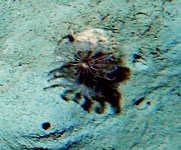

 | |||||||||||||||
|
|
Journals 2008/2009Roy Arezzo
August 3, 2008 The Drake Passage was kind to us. Beyond "The Horn" to the east of Argentina, below the Strait of Magellan, was not so smooth. We are transitting back to Punta Arenis, Chile, where we have experienced some of the highest seas of the expedition - fortunately with successful sampling behind us, it does not affect our mission. Many folks were feeling the affects of the ship´s rolling and although I did not become sea sick, working behind the computer made my head swimmy and I took a nap before dinner. The night-shift scientists and many of the technicians have switched over to day work which makes meal time feel more social. The spirits are still high as folks anticipate the arrival in to port scheduled for early tomorrow morning. Up in the bridge there have been some interesting wildlife sightings; most notably, a small pod of orcas, more common in the northern seas. I found a small group of seals surfing our bow wake to be the most delightful. Most of the seals I have seen in the wild tend to be only visible from the neck up when not hauled out on ice or rocks. These seals were darting in and out of the waves in unison, and at first I mistook them for dolphins. As for science talk, there are a few loose ends that were being discussed by various members of the science team in the dry lab. Some of the sea cucumbers from the southern stations first through to be the Peniagone, have morphological differences as compared to the animals we had been observing throughout the cruise. It appears that they may be classified in a different taxonomic group, possibly genus Rhipidothuria. DNA testing will tell us more, when the genetic analysis results are in, back at the university labs. I made some time to finally thumb through the field guides the University of Hawaii team brought along for the cruise. Peniagone is a special creature with unusual motility for a deposit feeder. Of the holothurians, of which there is great diversity, there are few benthic sea cucumbers that actually swim. We have some video of a Peniagone swimming in our aquarium that many would find quite entertaining. "Swimming" may be a bit of an overstatement but by sea cucumber standards they are rather graceful. To the average observer they would appear as an undulating worm.
The field guides proved to be a good resource for distinguishing the deposit feeders from suspension feeders. Many of the organisms we study in this project (such as Peniagone) are referred to as deposit feeders; ingesting sediment and digesting off labile organic matter, releasing chemical nutrients at the seafloor similarly to the way earthworms affect terrestrial soil. Crinoids (another example of an echinoderm) are benthic organisms that are considered suspension feeders and have a significant role in the nutrient cycling story here on the Antarctic shelf. Crinoids, also know as sea lilies or feather stars, are related to brittle stars and can be found in other benthic ecosystems around the world. When we trawled the bottom we would often bring up the hard calcified base of the animal, without the feathery semblance of its characteristic "feeding arms," for which the common names are attributed. The arms help the animal feed by collecting food particles, most of which drift along with bottom currents, suspended in the water column. It took a few trawl sample inspections before I made the connection between the white skeletal remains in the net and the beautiful animal you see in the "Yoyo" bottom images.
The main group project of the day was cleaning the lab spaces. In order to achieve this goal we moved the remaining bulky science gear from the main deck down into the hold. Negotiating the stairs to the hold carrying boxes, coolers and pieces of equipment on the high seas required some care and skill. With the labs cleared out we conducted a top-to-bottom scrub down of the lab spaces to remove all evidence that this was a mud cruise. |
||||||||||||||


